Andean guan facts for kids
The Andean guan (Penelope montagnii) is a cool bird that lives high up in the Andes mountains. It's part of the same bird family as turkeys and chickens, called Cracidae. You can find it in countries like Venezuela, Colombia, Ecuador, Peru, and Bolivia.
Quick facts for kids Andean guan |
|
|---|---|
 |
|
| P. m. montagnii, Colombia | |
| Conservation status | |
| Scientific classification | |
| Genus: |
Penelope
|
| Species: |
montagnii
|
| Subspecies | |
|
|
 |
|
What Do They Look Like?
Andean guans are medium-sized birds. They are usually about 40 to 58 centimeters (16 to 23 inches) long. They weigh around 500 to 840 grams (1 to 1.8 pounds). They look a bit like slender turkeys with long bodies, thin necks, and small heads.
Their feathers are mostly brown. The feathers on their head, neck, and chest have white edges, making them look pretty. They also have a bright red flap of skin under their chin, called a dewlap, and reddish legs.
Once, a special Andean guan was found that had much lighter feathers than usual. Most of its body was white, except for its forehead, chin, and upper throat, which were normal brown. This bird might have had a condition that made its feathers lighter. It seems this unique bird might have been kept in a cage for a while because it was so rare.
Where Do They Live and How Are They Doing?
Andean guans live in "cloud forests," which are misty, high-altitude forests. They sometimes follow groups of army ants. They probably do this to catch insects or other small creatures that the ants stir up.
They build their nests in trees and usually lay one egg at a time. Young birds have been seen with their parents in late June.
Like many animals, Andean guans are affected by people cutting down forests. They also get hunted for food. However, the Andean guan lives across a very large area. This means it is not currently in danger of disappearing from the world.
Because they live in high places, their homes might become broken up into smaller pieces over time. We don't have much information about how many Andean guans there are in total. But they do live in several protected areas. For example, you can find them in the Cocora valley in Colombia and the Yanacocha Reserve in Ecuador.




